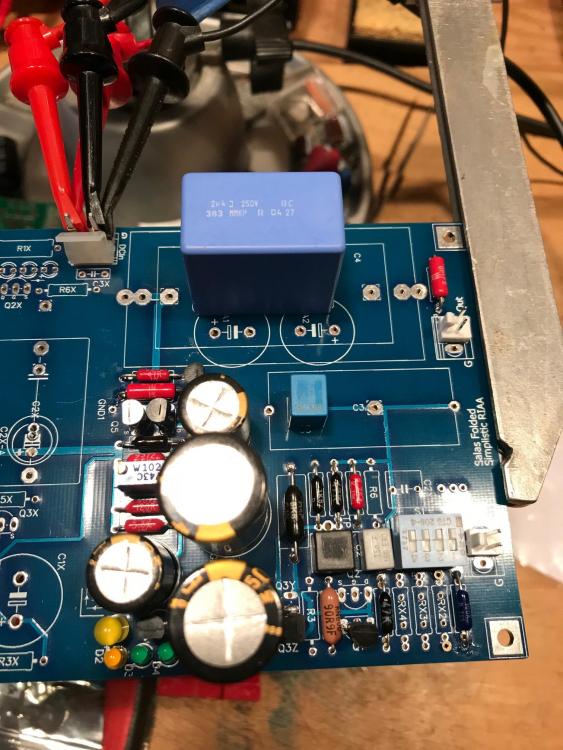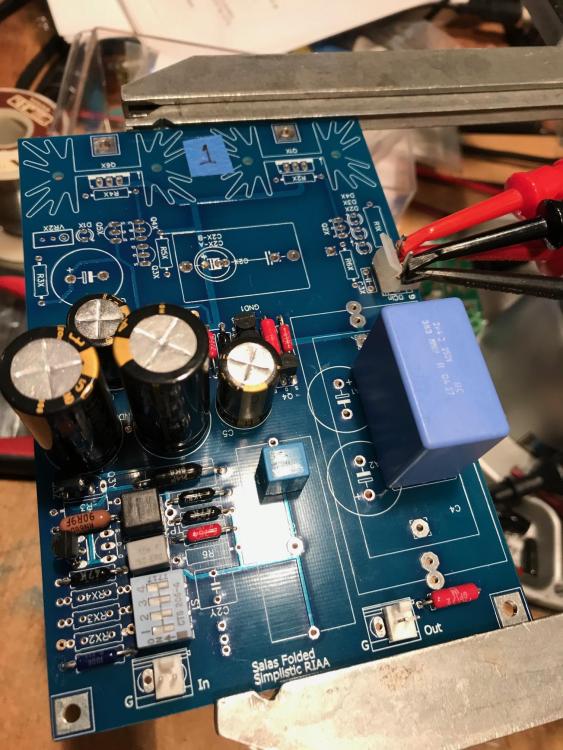-
Posts
8,555 -
Joined
-
Last visited
-
Days Won
7
Content Type
Profiles
Forums
Events
Everything posted by Pars
-
Paid, thanks Steve!
-

and now for something completely different part 3
Pars replied to kevin gilmore's topic in Do It Yourself
My take: I’ve only listened to either of these with orthos (modded fostex t50rp). I always found the Senn hd6xx to be too syrupy for my taste. I’ve never listened to the HD800s (I know Kevin really likes the ss Dynalo with these). This is comparing an SE CFP to a balanced SS Dynalo. First off, I don’t find the Dynalo to be more musical than the CFP. The CFP handles the orthos better, particularly in the bass. The CFP is neutral, though slightly darker than the Dynalo, which might just be a reflection on it being able to drive the orthos better with higher current capability. The CFP is using a single GRLV @+/-30V; the Dynalo also uses a single GRLV @+/-20V. Edit: I didn’t mention that the Fostexes are wired balanced, so the SS Dynalo is SE in->bal out Sent from my iPhone using Tapatalk -
This probably got buried in my post: No one has an opinion on shunt vs. linear reg for a phono stage? Specifically, Salas shunt vs. GRLV plus? Thanks for any thoughts! Sent from my iPhone using Tapatalk
-
Happy Birthday Tyler! Sent from my iPhone using Tapatalk
-
Thanks Ryan! Maybe I'll take you up on that once I have it built (kinda). This is set for somewhat specific loading for an AT ML440, so I would want to match it somewhat to your cart. I'll pm you when I have it more or less done and we can go from there. I haven't had a turntable setup in years. My table isn't exactly up to HC standards either (Thorens TD320).
-
Thanks Marc. Yes, I'll take one. Me: Salas Folded Simplistic Phono stage. I did my own board layout (in Diptrace), based on the diyaudio board, but made a few changes. I built these with parts I had laying around (other than the 2SK369BL quad from Tea Baf on diya and 2SK117GR JFETs which MA Santos was very kind to send to me, as the ones I had weren't high enough in IDSS). Resistors are a combination of Holco 0.1%, PRP, and for values I didn't have, Welwyn RC55 0.1%. I'll probably replace some of the PRPs with Welwyns as well. The caps I had around (MKP1837 and BC MMKP 383), but will probably replace these with some Mundorf Supremes. Target case is a Modushop Slim Line 1U (team single chassis). Both boards worked fine on initial power up. I am currently leaning towards powering these with either 1 or 2 GRLV plus boards set at 35V (have one built and tested). If anyone has a good reason to instead use the Salas shunt regs (which I have on the boards, just not populated), let me know what you think. I know a lot of people ooh and ahh over shunt regs, but I'm not quite so sure they are automatically better than a good linear regulator such as the GRLV. Salas' do have a good reputation however.
-
I guess I'd be interested in one of the boards. PM me with details. I looked at the Muffsy website and found the hifisonix project, but didn't see a BOM. Do these come with the components?
-
I might be interested in one of these if you have any left Marc. Or borrowing yours... Where did you get the cute little case for this? Sent from my iPhone using Tapatalk
-
The jpg are the only schematics that Kerry provided for the mini. I may draw a set up if I have time, as the legibility of these leaves something to be desired. The ss Dynalo (and Dynahi) will handle any combination of input/output. 1) balanced in/balanced out 2) single ended in/balanced out 3) single ended in/single ended out 4) balanced in/single ended out If you opt for only a balanced output jack(s) you won’t be able to provide single ended out without some pre-planning. The mini as Kerry has defined it provides both a 4-pin balanced XLR and a standard 1/4” stereo single ended output. Single ended input loses ~6dB compared to balanced in. Sent from my iPhone using Tapatalk
-
The supersymmetry input section does unbalanced to balanced conversion. You can use either single-ended or balanced sources with this. For single-ended source, the - inputs should be grounded. You might try actually reading the thread... Sent from my iPhone using Tapatalk
-
Hi Gael, How long until you get the prototype? As for lead times, I guess I never asked when I was talking to CAM Expert, but I was under the impression that it would have been 2 weeks or less with them? John has ordered from them before, but shipping to Australia I'm sure takes some time I'm certainly no typeface expert. The fonts that John used in FPE Frontdesign were Asian 1 stroke (for the supersymmetry) and Euro 5-stroke for the Dynalo. He did do some manual kerning by doing the "D" and "y" of Dynalo individually and arranging the spacing. He used 10% incline to mimic italics. From your samples, I like the Hiragano Maru Gothic, but don't care for the Silom. I like the Gil Sans Bold but the all caps on the DYNALO is too much, particularly with that font. You might also look at Calibri or Futura if you have those (typical Microsoft Office stuff).
-
^ That (interface) was because they also copied the Cisco IOS (including comments and bugs). When I worked for Tellabs, during an optical tradeshow, we caught two of their engineers attempting to disassemble and photograph a piece of our equipment on the show floor after hours.
-
^ ouch! Those are expensive for what they are! I’ve already got what I might need from my last order from seeed, so I may drop those... Sent from my iPhone using Tapatalk
-
Happy Birthday Doug!
-
Yes. I won't share that one however. Let me clean something up and I'll send it to you. EDIT: see attached. Allows color selection for jacks, THAT340 or JFET, onboard or Amb regs (including associated parts). EDIT2: Replaced file; description wrong on 160K for Amb reg. Also note that the JFET selections chooses the TO71 package. The SOT223 package is a bit cheaper, so you would have to manually handle that. Also, many of these parts are small. You might want to order extra. Also, the Elna Silmics don't fit worth a crap, and didn't sound better (sounded worse to me). Not recommended. ssdynalo-v1-4 cby.xlsx
-
Ooops, yes should have clarified that On Semi is EOLing them. Sent from my iPhone using Tapatalk
-
After building the 3 minis, I’m not in any hurry to do any SMT anytime soon Though changing out the th caps on one board wasn’t any fun. Just got a notice from Mouser that the MBTA06/56 used on the mini is EOL. Now they are discoing SMT parts, not just TO92s. Haven’t checked to see what good replacements might be. Sent from my iPhone using Tapatalk
-
You can find most of these in the DIY section. Some hints on ones that won’t be obvious: 3. And now for something completely different 4. Dynalo Mk2, mini version (no sep thread for this one) 6. Std pot for Dynalo Mini, but can be used for many balanced amps 7. Schottky discrete rectifier board (GRLV) 8. Pot board with Phoenix and Molex KK connectors. Will work for Alps RK27 (blue), TKD 2/4CP 601 and 2500 pots 9. Use discrete transistors or FETs instead of the THAT340 chips in amps that use them Sent from my iPhone using Tapatalk
-
It’s always a good idea with these to start with the pots centered and incrementally adjust the offset out, then set the bias (IIRC correctly the adjustment procedure). You can get the pots approximately centered by using an ohmmeter and getting both sides to read approximately the same wiper to end terminal. Sent from my iPhone using Tapatalk
-
What was wrong in your biasing technique? Is this with the replaced resistors? What is bias set at now? Sent from my iPhone using Tapatalk
-
Look in the Stax thread for the current archive location. Sent from my iPhone using Tapatalk
-
OK I would measure them. Typ is 1.7V; max is 2.2V. We used to match LEDs for these, more important back when there weren't pots for offset. OK I've seen or heard of resistors being mismarked. Since you have the same problem on both boards, unlikely however (unless it is the whole batch of one value).
-
Doubtful that you fried any devices unless you connected the power backwards. When you say you replaced resistors with 340R, these were the 500R resistors? And those clear LEDs, have you verified their forward voltage as 1.7V with a meter? No PNPs where an NPN should be and vice versa? All resistors ohm out as their marked value?
-
Did a quick search back for copper weight and saw the 3oz recommendation. Ran across the special audiophool cable that blew up some poor guys actual KSA5 and found that those fucks are still in business! Revelation Audio Labs jeebus...







